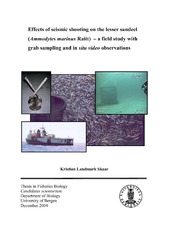| dc.contributor.author | Skaar, Kristian Landmark | eng |
| dc.date.accessioned | 2006-06-21T12:30:54Z | |
| dc.date.available | 2006-06-21T12:30:54Z | |
| dc.date.issued | 2004 | eng |
| dc.identifier.isbn | 82-8088-472-6 (electronic version) | en_US |
| dc.identifier.uri | http://hdl.handle.net/1956/1359 | |
| dc.description.abstract | Seismic shooting with airguns has been conducted continuously in the North Sea for about 40 years. In the past two decades there has been conflicts of interest between Norwegian industrial trawlers fishing for sandeel and seismic exploration activities in the North Sea. The fishermen have claimed that seismic shooting scares fish to flee to the bottom where the burry deep in the sediments and die. A common experience is that catchability is reduced for a period after seismic shooting. In May 2002, a field experiment on the effect of seismic shooting on the lesser sandeel (Ammodytes marinus) was conducted in the southeastern part of the North Sea. Buried sandeel were trapped in customized, bottomless, steel frame cages deployed during night on aggregations of sandeel located by a van Veen grab. Three cages were deployed in an experimental area and exposed to sounds from a standard threedimensional (3D) seismic survey for about 2.5 days. The behaviour of the fish caged fish were monitored and recorded with cameras mounted in one of the cage and on a remotely operated vehicle (ROV). A control area with two cages was established about 35 km southeast of the experimental area. Within the shooting area, a predetermined set of localities was repeatedly sampled by grab (van Veen) prior to and after seismic shooting. The seismic shooting had no immediate lethal effect on the sandeel. No dead sandeel was found in the grab samples and the total mortality in the cages was on average about 35 % both in the experimental and control groups. This mortality was probably a result of injuries due to handling and confinement. There was no significant difference in the catches of sandeel in the grab samples before and after shooting. Behaviour analyses from the video recordings showed that the caged fish did not flee to the bottom exposed to seismic shooting. They reacted to the shooting by performing C-starts and increased tailbeat frequency. Almost all C-starts were recorded during seismic shooting, none was recorded before and only one was recorded after. The tailbeat frequency was significantly higher both during and after than prior to seismic shooting and it did not return to preshooting levels during the 3-day period after the shooting ended. Some of the results differ from other results found in comparable studies. The sandeel lacks swimbladder and are thought to have poor hearing abilities and this is suggested to be an explanation for these differences. | en_US |
| dc.format.extent | 1265220 bytes | eng |
| dc.format.mimetype | application/pdf | eng |
| dc.language.iso | eng | eng |
| dc.publisher | The University of Bergen | en_US |
| dc.title | Effects of seismic shooting on the lesser sandeel (Ammodytes marinus Raitt) - a field study with grab sampling and in situ video observations | en_US |
| dc.type | Master thesis | |
| dc.rights.holder | The author | en_US |
| dc.rights.holder | Copyright the author. All rights reserved | en_US |
| dc.subject.nsi | VDP::Matematikk og Naturvitenskap: 400::Zoologiske og botaniske fag: 480::Marinbiologi: 497 | nob |
